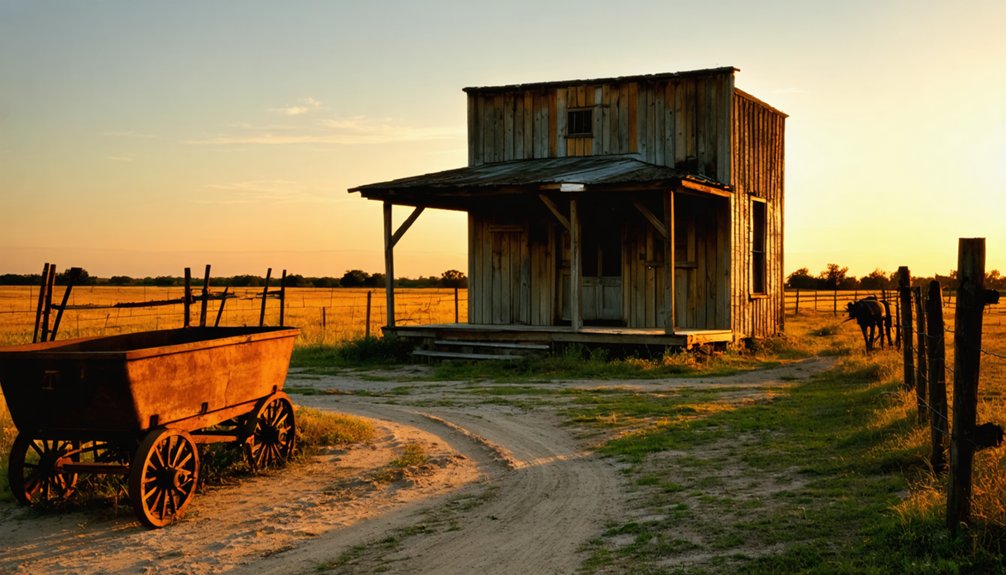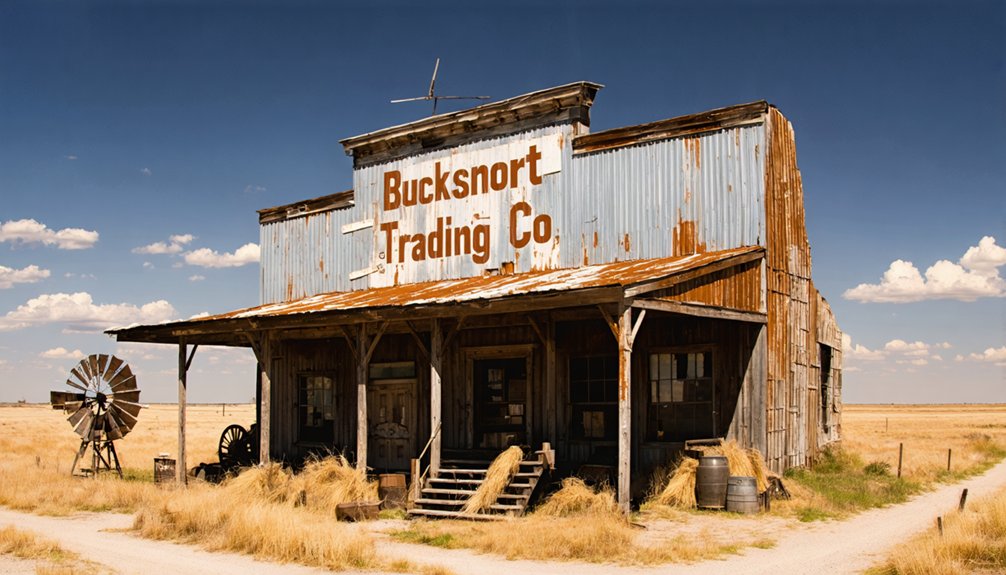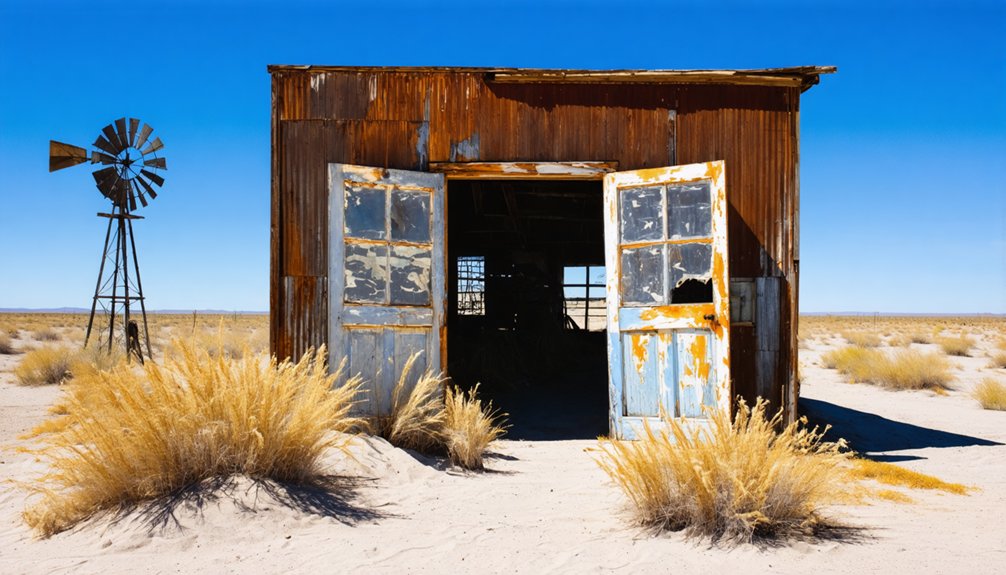You’ll find Bucksnort’s remains near the historic falls of the Brazos River in Falls County, Texas, where it emerged in 1837 as Jarrett Menefee’s Supply Station. The frontier settlement served as a crucial stagecoach stop, featuring a general store, saloon, and blacksmith shop. Originally named after an intoxicated patron, it was later renamed Buena Vista in 1848. The site’s rich history of frontier life, Native American interactions, and early Texas settlement awaits exploration.
Key Takeaways
- Founded in 1837 as Menefee’s Supply Station, Bucksnort was a vital stagecoach stop near the Falls of the Brazos River.
- The town got its unique name from a drunk patron at the local saloon before being renamed Buena Vista in 1848.
- Bucksnort served as a transportation hub with essential services including a general store, blacksmith shop, saloon, and post office.
- The settlement’s decline began in 1851 when Marlin became Falls County’s seat, leading to loss of political and commercial significance.
- Today, the ghost town’s legacy is preserved through a county park and historical marker overlooking the Brazos River.
The Birth of a Frontier Settlement (1837)
While Texas was still recovering from its revolution in 1837, the frontier settlement of Bucksnort emerged on a 320-acre prairie owned by Thomas J. Chambers.
In the wake of Texas’s revolution, Bucksnort took root in 1837, a frontier outpost on Chambers’ sprawling prairie tract.
You’ll find its origins as Jarrett Menefee’s Supply Station, strategically positioned near the Falls of the Brazos River, where frontier challenges shaped daily life. The settlement’s dynamics reflected the determination of early Texas pioneers, including the Marlin and Menefee families, who’d returned after the tumultuous Runaway Scrape.
Located five miles northeast of the Falls and below Fort Milam, Bucksnort quickly became a crucial stagecoach stop. The area’s dramatic ten-foot drop in the Brazos River created a distinctive landmark for travelers and settlers alike.
You’ll appreciate how the settlers chose this location wisely – the Brazos River provided essential water access and a convenient ford crossing, while the open prairie offered prime conditions for ranching and farming operations. Los Brazos De Dios, as the river was named, served as a lifeline for both travelers and livestock in the region.
Origins Behind the Unique Name
Frontier folklore traces Bucksnort’s distinctive name to an intoxicated saloon patron at Jarrett Menefee’s Supply Station in 1837.
The quaint origins reflect the informal naming customs of Texas frontier settlements, where personal incidents and local characters often influenced place names rather than bureaucratic processes. Like Tennessee’s Bucksnort, named after William Buck Pamplin, the tales often involve colorful local figures. In 1848, the settlement underwent a significant change when it was renamed Buena Vista.
While other Bucksnort towns across America share similar humorous anecdotes connecting their names to whiskey drinking or moonshine figures, this Texas settlement’s story stands uniquely its own.
The Robertson County Commissioners Court officially recognized the name on February 8, cementing what began as frontier humor into historical record.
You’ll find that the name’s endurance in historical accounts, despite the settlement’s extinction by 1852, speaks to the lasting appeal of its colorful backstory.
Life in Early Bucksnort
Beyond its humorous name, Bucksnort emerged as a thriving settlement on Thomas J. Chambers’ 320-acre prairie in 1837. Settler experiences revolved around a vibrant community dynamic that included essential services and social gatherings. The settlement’s strong defenses included fort-like homes that protected residents from potential threats. The community was first established as Jarett Menefees Supply Station before adopting its peculiar new name.
You’d find a bustling hub where stagecoaches stopped, mail arrived, and news spread through the local saloon.
- A general store and blacksmith shop served as the backbone of daily commerce
- Children attended the local school while adults conducted business
- The racetrack provided entertainment and social connections
- Stagecoach stops brought mail, supplies, and news from distant regions
- Agricultural activities and ranching operations sustained the economy
The settlement’s prime location near the Brazos River and Fort Milam made it an ideal spot for early Texas pioneers seeking opportunity and independence.
Community Establishments and Services
You would’ve found Bucksnort’s establishments concentrated around Jarrett Menefee’s Supply Station, a 320-acre prairie hub that featured a general store, saloon, and blacksmith shop serving both settlers and travelers.
Similar to Old Alton Bridge, only remnants and ruins of Bucksnort’s original structures remain visible today.
The community’s stagecoach stop doubled as a post office, making Bucksnort a crucial communication and transportation center in mid-19th century Texas.
A local racetrack and stable provided entertainment while supporting the town’s transportation needs, though these amenities, along with other services, ceased operation as Bucksnort declined by 1852.
Daily Life Amenities
During its peak in the 1840s, Bucksnort hosted a variety of essential establishments that served both practical and social needs.
You’d find everything necessary for frontier life, from education to entertainment, supporting both daily routines and community gatherings. The town’s infrastructure reflected a vibrant settlement where you could conduct business, socialize, and maintain your homestead. The community was initially developed from Jarett Menefees Supply Station, gradually expanding into a more complex settlement.
- A general store stocked with frontier essentials and daily supplies
- A blacksmith shop for vital repairs and maintenance of farming equipment
- A school that doubled as a community hub for local families
- A saloon and racetrack for entertainment and social connections
- A stagecoach stop with postal services linking you to the outside world
These amenities helped transform Bucksnort from a simple supply station into a structured frontier community where you could build a sustainable life.
Commerce and Transportation Hub
The strategic location of Bucksnort as Jarrett Menefee’s Supply Station transformed this 320-acre prairie settlement into a significant commercial crossroads.
You’d find a bustling hub where commerce dynamics shaped daily interactions through the general store, blacksmith shop, and saloon, which doubled as an informal postal center.
The transportation evolution centered on the stagecoach stop, which served as the community’s official post office.
You could’ve witnessed the constant flow of travelers and goods, supported by fundamental infrastructure including stables, a racetrack, and proximity to the Brazos River ford.
The settlement’s position below Fort Milam made it a crucial link between military operations and emerging towns like Marlin, creating a network that sustained regional trade until changing settlement patterns led to its decline by 1852.
Like other boom settlements, the area experienced a swift decline in population due to diminishing resources, mirroring the fate of towns like Best, Texas.
The region’s harsh environment brought frequent dust storms that challenged the daily lives of settlers and travelers alike.
Transportation Hub and Stagecoach Stop

Situated on a strategic 320-acre prairie, Bucksnort’s prominence as a stagecoach stop began in the 1840s when it emerged as an essential transportation hub connecting nearby communities.
You’ll find its legacy intertwined with early Texas settlement, as stagecoach routes converged here to support regional commerce and communication. The stop’s postal services made it a crucial link for settlers seeking to maintain connections with distant family and business partners.
- Combined post office and stagecoach stop services in one convenient location
- Supported travelers with amenities including a general store, blacksmith shop, and stable
- Featured a racetrack for horse management and team changes
- Connected to Fort Milam and other key settlements via major travel routes
- Facilitated migration and trade during Texas’ early expansion period
Geographic Significance in Falls County
Located near the historic falls of the Brazos River in Falls County, Bucksnort occupied a strategic position where the river once dropped a dramatic 10 feet.
You’ll find its unique geographic positioning at the only hard-bottom ford within 200 miles of the coast, making it essential for frontier travelers crossing the Brazos.
The falls marked the limit of river navigation for steamboats, naturally concentrating settlement patterns around this critical crossing point.
When the Brazos changed course in 1866, the rapids decreased to just 2 feet, altering the region’s dynamics.
While Bucksnort’s 320-acre prairie settlement initially thrived due to its location east of the river, the changing landscape and emergence of nearby Marlin ultimately led to its decline.
The settlement’s extinction by 1852 reflects how geography shaped the destiny of early Texas communities.
Administrative Changes and County Formation

You’ll find Bucksnort’s administrative history marked by significant jurisdictional shifts, as it moved from Robertson County’s control in 1834 to Limestone County in 1846.
When Falls County was created in 1850, Bucksnort became part of its territory as Precinct 2, reflecting Texas’ evolving county boundary system during early statehood.
These administrative changes occurred during a period of regional reorganization that ultimately contributed to Bucksnort’s diminishing role as a settlement by 1852.
County Boundary Shifts
When Falls County emerged on January 28, 1850, it reshaped the administrative landscape by consolidating portions of Limestone and Milam counties, placing Bucksnort within its newly established boundaries. The county boundary impacts remained unchanged after formation, creating a stable but ultimately challenging environment for Bucksnort’s survival.
The administrative consolidation effects proved significant, especially after Marlin became the county seat in 1851.
- Falls County’s borders were partially defined by the Brazos River and its notable falls
- Robertson County’s earlier jurisdiction over Bucksnort ended with the 1850 boundary shifts
- The Brazos River’s course change in 1866 didn’t alter county lines
- Bucksnort’s governance transferred completely to Falls County authority
- No further territorial changes occurred to potentially revitalize the settlement
Political Jurisdiction Evolution
As Texas shifted from independence to statehood, Bucksnort’s political jurisdiction underwent significant changes that shaped its brief existence.
You’ll find that before Falls County’s creation in 1850, the settlement operated under Limestone and Milam counties’ authority. The community’s political significance peaked in 1848 when Robertson County officially recognized it as an administrative center for elections and postal services.
The jurisdictional changes accelerated after Falls County’s formation, with Marlin becoming the county seat in 1851.
You can trace Bucksnort’s decline through these administrative shifts, as the settlement lost its political relevance by 1852. The establishment of Falls County’s permanent boundaries and Marlin’s rise as the administrative hub effectively ended Bucksnort’s role in local governance.
New Administrative Districts
The formation of Falls County on January 28, 1850, marked a pivotal shift in the region’s administrative structure, carving out new boundaries from Limestone and Milam counties.
You’ll find that these administrative shifts transformed the area’s settlement patterns, leading to significant changes in local governance and community development.
- The county’s establishment brought clear jurisdictional boundaries, replacing the previous complex system of land grants.
- Viesca’s brief tenure as county seat gave way to Adams (later Marlin) through a decisive 20-0 vote.
- New settlements emerged as populations shifted away from older communities like Bucksnort.
- The Falls on the Brazos River served as a natural landmark for defining district boundaries.
- Administrative stability helped establish Marlin’s dominance as the county’s governmental center.
The Decline of a Prairie Town

Like many frontier settlements of its era, Bucksnort’s decline emerged from a perfect storm of challenges in the mid-1800s.
You’ll find that persistent Native American raids first disrupted settler experiences in 1836, forcing a temporary exodus during the Runaway Scrape. Even Fort Milam, built to protect residents, couldn’t prevent the conflict impacts that ultimately pushed settlers to abandon their homes.
While Bucksnort initially thrived with a school, general store, and stagecoach stop, you’d have seen its prominence fade as nearby towns like Marlin grew.
The community’s economic foundation crumbled when railroads bypassed the settlement, and residents scattered to more promising locations.
Historical Preservation and Legacy
Despite decades of abandonment, Bucksnort’s historical legacy lives on through preservation efforts at its original site near Farm to Market Road 712, where you’ll find a county park and historical marker overlooking the Brazos River.
Nestled along Farm to Market Road 712, Bucksnort’s preserved heritage endures at a scenic park overlooking the mighty Brazos.
While preservation challenges include limited original structures and a scarce archaeological record, the site’s historical significance remains crucial to understanding Texas’s frontier development.
- Sterling C. Robertson established the settlement in the 1830s as part of early Texas colonization
- You can explore the former stagecoach stop’s location at the Brazos River falls
- Local historical societies maintain heritage festivals and educational programs
- The site provides insights into settler and Native American interactions
- School groups regularly visit to study Texas colonial history through tangible remnants
Distinguishing Falls County’s Bucksnort
While several Texas ghost towns share the name Bucksnort, Falls County’s historic settlement stood apart through its strategic location and brief but impactful existence.
You’ll find this particular Bucksnort’s legacy five miles northeast of the old Falls on the Brazos River, where settler experiences shaped a vibrant frontier community during the 1840s.
The settlement’s unique position near Fort Milam and crucial Brazos River crossing points made it essential to regional defense and transportation networks.
Community dynamics centered around a bustling hub that included a school, general store, saloon, and stagecoach stop.
You can distinguish this Bucksnort by its connection to prominent settler families like the Marlins and Menefees, who established the community in 1837 following the Runaway Scrape.
Frequently Asked Questions
What Was the Population of Bucksnort at Its Peak?
Like a ghost slipping through history’s fingers, you’ll find Bucksnort’s peak population isn’t precisely documented. Based on Bucksnort demographics and similar Texas ghost towns, you’re looking at roughly 150-300 residents maximum.
Are There Any Surviving Photographs of Bucksnort’s Original Buildings?
You won’t find any surviving photographs in historical preservation records or photographic archives. The settlement was extinct by 1852, before photography became widespread in Texas’ frontier communities.
What Native American Tribes Lived in the Bucksnort Area?
You’ll find the area’s tribal history includes the Waco, Tawakoni, and Anadarko as primary hunters, with Cherokees settling briefly in the 1830s. The cultural significance shows no permanent settlements existed before 1829.
Did Any Notable Historical Figures Ever Visit Bucksnort?
You won’t find records of any famous visitors or major historical events at Bucksnort. While nearby Fort Milam attracted notable figures, this small supply station’s brief existence didn’t draw prominent personalities.
What Happened to the Families Who Left Bucksnort?
You’ll find that families mostly moved to Marlin, the new county seat, where they built lasting legacies. Their migration patterns led them to establish businesses, plantations, and community organizations throughout Falls County.
References
- https://www.texasalmanac.com/places/buck-snort
- https://www.tshaonline.org/handbook/entries/bucksnort-tx
- https://www.forttours.com/pages/hmfalls.asp
- https://www.fchc.info/bucksnort_chronicles.html
- https://kids.kiddle.co/Sarahville_de_Viesca
- http://www.forttumbleweed.net/historymarlin.html
- https://www.texasescapes.com/CentralTexasTownsNorth/Bucksnort-Texas.htm
- https://dbpedia.org/page/Sarahville_de_Viesca
- https://en.wikipedia.org/wiki/Sarahville_de_Viesca
- https://sites.rootsweb.com/~txfalls/Historical_Markers/Historical_Marker_Webpages/HistoricalMarker_Bucksnort.html



